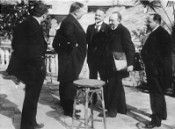
The Treaty of Rapallo signed
April 16, 1922 during the Genoa Conference, the RSFSR and the Weimar Republic signed an agreement in Rapallo (Italy), which meant the political recognition of Soviet Russia by Germany, the establishment of diplomatic relations between them and expansive economic cooperation.
In 1921, the Allied countries offered the Soviet government to take part in an international conference to resolve disputes related to the economic claims of the West to Russia. If adopted, the European countries promised to officially recognize Soviet Russia. The Genoa Conference, opened in April 1922, was attended by 29 countries - Russia, Britain, France, Germany, etc.
During the conference, the Soviet government managed to conclude the Treaty of Rapallo of 1922 with Germany. On behalf of Russia (RSFSR), the agreement was signed by Georgi Chicherin; on behalf of Germany (Weimar Republic) – by Walther Rathenau.
The Treaty of Rapallo provided for an immediate and complete resumption of diplomatic relations between the RSFSR and Germany. The parties mutually renounced claims to compensation for military costs and nonmilitary losses, and agreed on how to resolve differences between them. Germany recognized the nationalization of the German public and private property in the RSFSR, and refused claims arising from "the activities of the RSFSR, or its agencies with respect to German nationals or in their private rights, provided that the Government of the RSFSR would not satisfy similar claims of other states."
Both sides recognized the principle of most favored as the basis of their legal and economic relations and pledged to promote trade and economic relations. The German government stated its willingness to provide assistance to German companies in developing business relations with the Soviet organizations.
The treaty was concluded without a time limit. Under the agreement, signed November 5, 1922 in Berlin, it was extended to other Soviet republics.
The Treaty of Rapallo marked the end of the international diplomatic isolation of the RSFSR. For Russia, it was the first full-fledged treaty and de jure recognition as a state, while for Germany it was the first one enjoying equal rights after the Treaty of Versailles.
Firmness of the provisions of the Treaty of Rapallo of 1922 was confirmed by the Treaty of Berlin of 1926.
Lit.: Горлов С. А Совершенно секретно: Альянс Москва – Берлин, 1920-1933 гг. (Военно-политические отношения СССР — Германия). М., 2001; То же [Электронный ресурс]. URL:http://militera.lib.ru/research/gorlov1/index.html; Индукаева Н. С. История международных отношений 1918-1945 гг. Томск, 2003; Павлов Н. В. Внешняя политика Веймарской республики (1919–1932). [Электронный ресурс] // MGIMO.ru. 2011. Октябрь. URL: http://www.mgimo.ru/files/210929/Weimar.pdf; Рапалльский договор между РСФСР и Германией. 16 апреля 1922 г. // Известия. № 102 (154!). 10 мая 1922 г.

